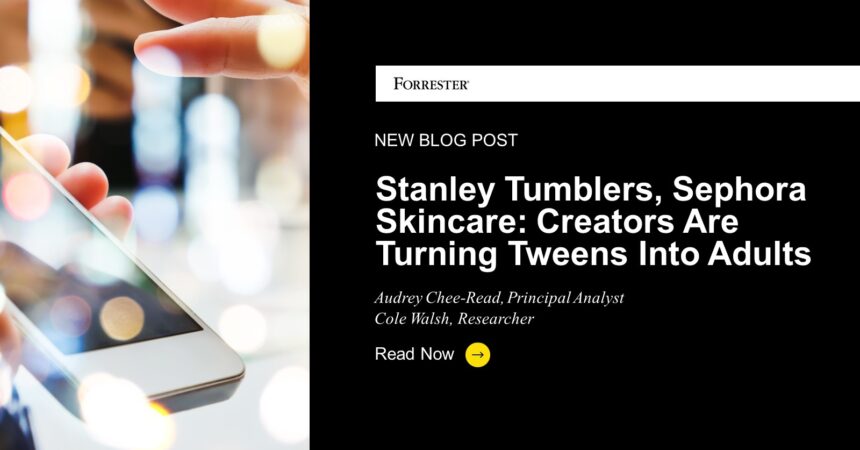In 2000, the hottest holiday gifts for tweens were Bratz dolls and the Nintendo Wii. In 2023, they were 64-oz. Stanley tumblers and skincare products from Sephora. My, how have the times changed. But why? It’s because of the unique impact of the creator (also known as the influencer). Specifically, Gen Alpha (those born after 2010) are now coming of age hyperconnected to social media and devices.
Among all generations, they are the most impressionable to creator content, even compared to teens just a few years older. According to Forrester’s Youth Survey, 2023, 50% of US online tweens (12–13-year-olds) said creators are likely to influence what they purchase; 43% of 16–17-year-olds said the same. Tweens’ purchase decisions are also more susceptible to the influence of trends and social media than older teenagers: 69% of 12–13-year-olds are influenced if it is popular among their friends/family (vs. 58% of 16–17-year-olds), and 37% of 12–13-year-olds are influenced by products if they are trending on social media (vs. 30% of 16–17-year-olds). Older teenagers tend to veer toward functional practicality — 48% of 16–17-year-olds are influenced by design and 74% by price vs. 39% and 60% of 12–13-year-olds, respectively.
This data came to life in a recent conversation with a teenager, “Alice.” She confirmed that the hottest gift for her and her friends were the 64-oz. Stanley tumblers. But Alice didn’t learn about the Stanley tumbler from her friends — she was inspired by Cecily Bauchmann, a 35-year-old mother of four on TikTok. According to Alice, this is quite normal: “I typically follow influencers who are older than me. Cecily is a lot older, but her family content is my favorite.” As it turns out, very few creators are the same age as their younger audiences. A recent Adobe study found that the average female creator is 38 years old and the average male creator is 43 years old. Brands should take note of this striking age difference because:
- Tweens’ behaviors and “maturity” continue to accelerate. Gen Alpha is at an impressionable life stage, influenced by creators who are much older, meaning that their preferences will invite questions of age-appropriateness. Soon, the “tween” phase will vanish.
- Age is becoming less of a mark of maturity for consumer research. As maturity in preferences supercharge, what tweens prefer is no longer defined by their age groups but rather their exposure to devices, personal interests, and social media. Looking toward behaviors, rather than age, will be the hallmark of audience definition.
- Brand trend backlashes will reach a fever pitch within the next two years. As trends grip audiences of all ages, Gen Alpha — hyper-aware observers — pose a unique opportunity and challenge for brands. Their embrace could catapult products to new heights, but brands must consider the potential consequences of backlash from older consumers who may perceive the association with tweens as undesirable.
Questions? Forrester clients should schedule an inquiry or guidance session. In the meantime, read more of our research to learn how to make the most of partnerships with creators.







